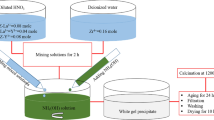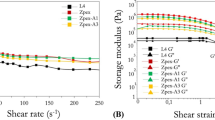The influence of boron oxide additives in amounts 0 to 11 mol.% on the melting properties of glasses in the system SrO–Al2O3–TiO2–ZrO2–B2O3–SiO2 for use as fillers in dental filling composites in order to lower the melting temperature to technologically acceptable values (≤ 1500°C) and to increase the transparency of the produced finely crushed glass. It was found that as the B2O3 content increases, the melting temperature can be lowered from 1600°C (in glass without added B2O3) to 1480°C at B2O3 content 11.8 mol.%, and the glass transition temperature drops from 820 to 743°C. Transparent glasses with light transmission 80%, which are promising for making filling composites, already obtain at 6 mol.% B2O3 with melting temperature 1500°C.



Similar content being viewed by others
References
K. K. Choi, J. L. Ferracane, T. J. Hilton, and D. Charlton, “Properties of packable dental composites,” J. Esthet. Dent., 12(4), 216 – 226 (2000).
K. F. Leinfelder, S. C. Bayne, and E. J. Swift, “Packable composites: overview and technical considerations,” J. Esthetic and Restorative Dentistry, 11(5), 234 – 249 (1999).
M. Makita, A. Nakatsuka, H. Takaki, et al., “Effects of barium concentration on the radio-opacity and biomechanics of bone cement: experimental study,” Radiation Medicine, 26(9), 533 – 538 (2008).
E. V. Carvallo, D. M. de Paula, D. M. Andrade Neto, et al., “Radio-opacity and mechanical properties of dental adhesives with strontium hydroxyapatite nanofillers,” J. Mechan. Behavior Biomed. Mater., 101, 103447 (2020).
Ulf Dahlmann, Sabine Pichler-Wilhelm, Jens Soffner, and Simone Monika Ritter, Pat. US 11136260 B2 United States IPC: C03C3/118, C03C12/00, C03C3/064. Radiopaque Glass and Use Thereof, applicant and assignee: SCHOTT AG. No. 16/377,270; filed 04/08/2019. 24 p.
Simone Monika, Oliver Hocherein, and Sabine Pichler Wilhelm, Pat. US 8268739 B2 United States IPC: C03C3/097, A61K6/71, A61K6/818, A61K6/822. X-Ray Opaque Barium-Free Glasses and Uses Thereof, applicant and assignee: SCHOTT AG. No. 12/695,419; filed 01/28/2010. 7 p.
Y. M. Sung, “Phase formation kinetics in SrO–Al2O3–SiO2–B2O3 glass,” J. Mater. Sci., 37(4), 699 – 703 (2002).
Author information
Authors and Affiliations
Corresponding author
Additional information
Translated from Steklo i Keramika, No. 11, pp.3– 8, November, 2022.
Rights and permissions
Springer Nature or its licensor (e.g. a society or other partner) holds exclusive rights to this article under a publishing agreement with the author(s) or other rightsholder(s); author self-archiving of the accepted manuscript version of this article is solely governed by the terms of such publishing agreement and applicable law.
About this article
Cite this article
Zinina, E.M., Savinkov, V.I., Klimenko, N.N. et al. Influence of Boron Oxide on the Technological Properties of Strontium Aluminosilicate Glasses for Dentistry. Glass Ceram 79, 439–442 (2023). https://doi.org/10.1007/s10717-023-00528-2
Received:
Published:
Issue Date:
DOI: https://doi.org/10.1007/s10717-023-00528-2




